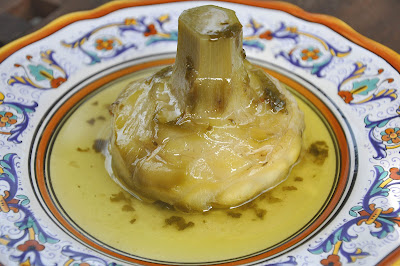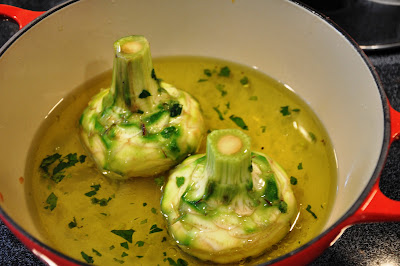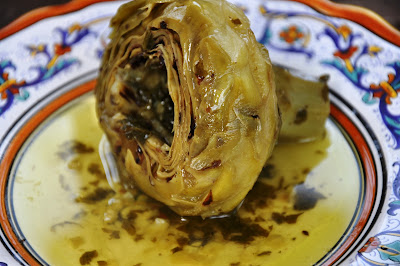One of the iconic dishes of Roman cookery, stracetti con la rughetta, or 'little rags' with arugula, is also one of the simplest of all to prepare:
Take beef, sliced as thinly as possible and cut into short strips, and sauté it over a very high flame with a clove or two or slightly crushed garlic until it has just lost its raw color. Season liberally with salt and pepper, mix and remove from the heat. Throw is a few handfuls of raw arugula, toss until they have wilted, and serve immediately with a nice piece of crusty bread to sop up the delicious juices.
NOTES: The dish is best made with 'baby' arugula, which will wilt on contact with the hot beef and residual pan heat. If you have more 'mature' arugula, you may want to keep the skillet on the heat while you toss the beef 'rags' and greens together until they wilt. If you don't have arugula on hand or prefer a less assertive taste, baby spinach leaves (or a mixture of spinach and arugula leaves) would also work nicely.
Depending on the cut of beef (see below) and the thickness of your slices, as well as the intensity of your heat source, the meat may give off liquid when you add it to the skillet. Not to worry, this is just fine, even desirable, as the cooking juices make a wonderful sauce for dipping bread into. Personally, however, I like to slice my beef paper-thin and keep the heat high for a 'dry' version of the dish. It is perhaps the closest think in Italian cooking to a 'stir fry'.
One of the most common cuts of beef you'll find in an Italian supermarket or butcher are fettine di manzo, or sliced beef, which to make straccetti you beat a bit to flatten and then cut into 'rags'. In Rome, they also sell straccetti pre-flattened and cut up. Elsewhere, you may need to slice and pound the beef yourself. The cut will depend on your taste, but I find that ribeye combines great flavor with tenderness. Skirt steak is another good choice. The genius of straccetti, however, is that you can also use humble cuts like chuck that would otherwise be too tough for this sort of 'flash' cooking. If you have access to a Korean supermarket like H Mart, by the way, they often sell beef slices for Korean 'barbecue' that are excellent for making stracetti.
Measurements are really pretty useless in this dish. The main point is to balance the amount of arugula against the amount of beef. Most recipes will call for roughly half as much arugula as beef by weight, but where the proper balance between the two main ingredients may lie is really up to you. Just be aware that when the leaves wilt they will reduce dramatically in volume, so if in doubt, add more than you think you need.
There are a good number of variations on this dish, mostly riffs on the arugula. As mentioned, spinach provides a less assertive alternative to arugula. In Roman Jewish cooking, straccetti are paired with thin wedges of sautéed artichoke, which is also a lovely combination. Sautéed mushrooms are another possible combination, either instead of or in addition to arugula or spinach. Some recipes call for little cubes of raw tomato. Some recipes call for shallot or onion instead of garlic. And some recipes eschew the veg altogether and call for the 'rags' to be flash-fried in a garlic and rosemary soffritto. And for a slightly 'fancier' dish, you can top the dish with shavings of parmesan cheese and/or a few drops of balsamic vinegar—but for me, straccetti are typical cucina povera and the idea of dressing them up does not really compute. But if you like fancy, straccetti can be also made from veal.
Arugula, by the way, is called rughetta in Roman dialect, hence the name of the dish. But you will also find it called straccetti if manzo con la rucola, since rucola is the standard Italian word for arugula. In Italy it grows wild all over the place and has always been considered a poor man's green. Funny to think that in some circles in the US it is seen as an 'elitist' vegetable! Arugula has a nature affinity with beef, and can also be found in one of my favorite ways of grilling steak called tagliata. (See my early post on an Italian cookout).





